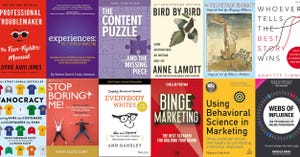Latest News and How-Tos
thumbnail
Strategy & Planning
How Bold Marketers Can Win on an AI-Dominated Playing FieldHow Bold Marketers Can Win on an AI-Dominated Playing Field
Marketing infrastructure rewards boring. But your customers won’t. Learn how humans can power the much-needed disruption in this discussion with the author of Audacious: How Humans Win in an AI Marketing World.











![How 6 Leading Brands Use Content To Win Audiences [E-Book] How 6 Leading Brands Use Content To Win Audiences [E-Book]](https://eu-images.contentstack.com/v3/assets/blt663d10211b43b0ca/blt251b76e81aca7c3d/67d47538521a246a83d3267e/content-marketing-examples.png?width=300&auto=webp&quality=80&disable=upscale)






![Freelance or Full-Scale Agency? How To Choose the Right Path for You [Video] Freelance or Full-Scale Agency? How To Choose the Right Path for You [Video]](https://eu-images.contentstack.com/v3/assets/blt663d10211b43b0ca/bltefbe766c00f91f02/67cef03910f0ef2bb343e731/freelance-or-full-scale-agency.png?width=300&auto=webp&quality=80&disable=upscale)


![What’s the Future of Marketing Analytics in the AI Age? [Video] What’s the Future of Marketing Analytics in the AI Age? [Video]](https://eu-images.contentstack.com/v3/assets/blt663d10211b43b0ca/bltedf93bfc2613a8b0/67c9a7e1dd02454c51a22ce2/marketing-analytics-ai-age-video-thumbnail.png?width=300&auto=webp&quality=80&disable=upscale)







![Throw Out Your Editorial Calendar in Favor of This Marketing Strategy [Video] Throw Out Your Editorial Calendar in Favor of This Marketing Strategy [Video]](https://eu-images.contentstack.com/v3/assets/blt663d10211b43b0ca/blt65d1425aa40f3b92/67c9c28a89e523c585d1cd93/too-editorial-calendar-pillar-based-marketing.png?width=300&auto=webp&quality=80&disable=upscale)












